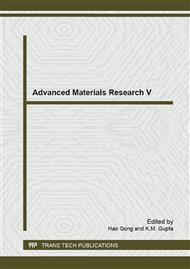[1]
Termentzidis and S. Merabia: Molecular dynamics simulations and thermal transport at the nano-scale (In tech. Publications, China 2012).
Google Scholar
[2]
A.A. Balandin, Thermal properties of graphene and nanostructured carbon materials: Nat. Mat. 10 (2011) 569-581.
Google Scholar
[3]
K.S. Novoselov, V. I. Fal'ko, L. Colombo, P.R. Gellert, M.G. Schwab, and K. Kim: A roadmap for graphene, Nature (London) 490 (2012) 192.
DOI: 10.1038/nature11458
Google Scholar
[4]
A.A. Balandin, Thermal properties of graphene and nanostructured carbon materials: Nat. Mat. 10 (2011) 569-581.
Google Scholar
[5]
A.K. Geim and K.S. Novoselov: The rise of graphene, Nat. Mater. 6, 183 (2007).
Google Scholar
[6]
F. Schedin, A. K. Geim, S. V. Morozov, E.W. Hill, P. Blake, M. I. Katsnelson, and K.S. Novoselov: Nat. Mater. 6, 652 (2007).
DOI: 10.1038/nmat1967
Google Scholar
[7]
A. A. Balandin, S. Ghosh, W. Bao, I. Calizo, D. Teweldebrhan, F. Miao, and C.N. Lau: Superior thermal conductivity of single-layer graphene, Nano Lett. 8 (2008) 902-907.
DOI: 10.1021/nl0731872
Google Scholar
[8]
T.Y. Ng, J. Yeo, Z. Liu: Molecular dynamics simulation of the thermal conductivity of short strips of graphene and silicene: a comparative study, Int J Mech Mater Des 9 (2013) 105-114.
DOI: 10.1007/s10999-013-9215-0
Google Scholar
[9]
K. Takeda and K. Shiraishi: Theoretical possibility of stage corrugation in Si and Ge analogs of graphite. Phys. Rev. B 50 (1994) 14916.
DOI: 10.1103/physrevb.50.14916
Google Scholar
[10]
X. Zhang, H. Xie, M. Hu, S. Yue, G. Qin, and G. Su: Thermal conductivity of silicene calculated using optimized Stillinger-Weber potential, Phys. Rev. B 89, 054310 (2014).
DOI: 10.1103/physrevb.89.054310
Google Scholar
[11]
E. Scalise, M. Houssa, G. Pourtois, B. Broek, V. Afanasev, and A. Stesmans: Vibrational properties of silicene and germanene, Nano Res. 6, 19 (2013).
DOI: 10.1007/s12274-012-0277-3
Google Scholar
[12]
H. P. Li and R. Q. Zhang: Vacancy-defect-induced diminution of thermal conductivity in silicene, EPL 99, 36001 (2012).
DOI: 10.1209/0295-5075/99/36001
Google Scholar
[13]
H. Xie, M. Hu, and H. Bao: Thermal conductivity of silicene from first-principles, Appl. Phys. Lett. 104, 131906 (2014), p.1.
Google Scholar
[14]
X. Lin, Y. Xu, S. Lin, A. A. Hakro, T. Cao, H. Chen, and B. Zhang: Optical and electronic properties of two dimensional graphitic silicon carbide, ArXiv e-prints 1205. 5404(2012) p.2.
Google Scholar
[15]
H. Sahin, S. Changirov, M. Topsakal, E. Bekaroglu, E. Akturk, R.T. Senger, and S. Ciraci: Monolayer honeycomb structures of group-IV elements and III-IV binary compounds: First-principles calculations, Phys. Rev. B 80 (2009) 155453.
DOI: 10.1103/physrevb.80.155453
Google Scholar
[16]
S. Plimpton: Fast parallel algorithms for short-range molecular dynamics, J. Comp. Phys. Vol. 117 (1995).
Google Scholar
[17]
J. Tersoff: New empirical approach for the structure and energy of covalent bonds, Phys. Rev. B Vol. 37 (1988).
Google Scholar
[18]
Information on http: /www. physics. iisc. ernet. in/PH208/Lecture208.
Google Scholar
[19]
K. Schelling, S. R. Phillpot and P. Keblinski: Comparison of atomic-level simulation methods for computing thermal conductivity, Phys. Rev. B Vol 65, 144306.
DOI: 10.1103/physrevb.65.144306
Google Scholar
[20]
D. L. Nika, E. P. Pokatilov, A. S. Askerov and A. A. Balandin: Phonon thermal conduction in graphene: Role of Umklapp and edge roughness scattering, Phys. Rev. B 79 (2009) 155413.
DOI: 10.1103/physrevb.79.155413
Google Scholar
[21]
X. Xu, L. Pereira, Y. Wang, J. Wu, K. Zhang, X. Zhao,S. Bae, C. T. Bui, R. Xie, J. Thong, B.H. Hong, K.P. Loh, D. Donadio, B. Li, B. Ozyilmaz: Length-dependent thermal conductivity in suspended single-layer graphene, Nat Commun. (2014) 4689.
DOI: 10.1038/ncomms4689
Google Scholar
[22]
D. L. Nika, S. Ghosh, E.P. Pokatilov, A. A. Balandin: Lattice thermal conductivity of graphene flakes: Comparison with bulk graphite. Appl. Phys. Lett. 94 (2009) 203103.
DOI: 10.1063/1.3136860
Google Scholar
[23]
L. Lindsay and D.A. Broido: Optimized Tersoff and Brenner empirical parameters for lattice dynamics and phonon thermal transport in carbon nanotubes and graphene, Phys. Rev. B 81(2010) 205441.
DOI: 10.1103/physrevb.82.209903
Google Scholar
[24]
E. Pop, V. Varshney, and A. Roy: Thermal properties of graphene: Fundamentals and applications. MRS 37 (2012) 203.
Google Scholar


